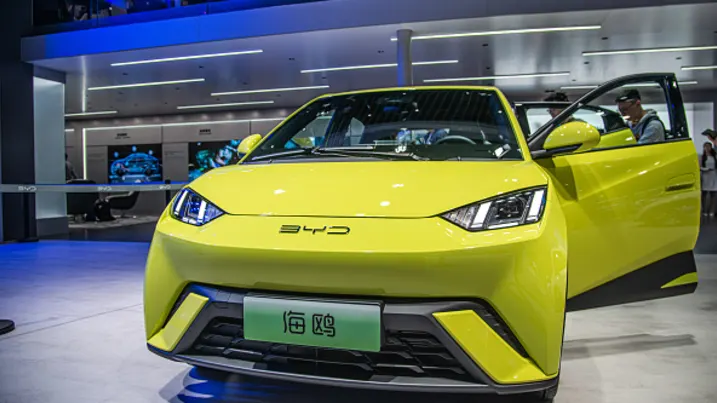BYD, the influential Chinese automaker, is making waves in the automotive industry with the launch of its new all-electric hatchback, the BYD Seagull. Priced at just 69,800 yuan (approximately $10,000), the Seagull is poised to disrupt the market by offering an affordable electric vehicle option that reportedly yields profits for the company.
The BYD Seagull’s competitive pricing has raised eyebrows among global automakers, sparking fears of increased competition and market saturation. There is growing concern that BYD and other Chinese rivals could inundate global markets, potentially undercutting domestic production and driving down vehicle prices.
Marin Gjaja, chief operating officer for Ford’s EV unit, expressed apprehension about the prospect of Chinese automakers entering the U.S. market during a recent interview with CNBC. Gjaja’s remarks reflect the industry’s acknowledgment of the growing influence of Chinese manufacturers and the potential challenges they pose to established players.
BYD’s success with the Seagull highlights China’s rapid advancements in electric vehicle technology and manufacturing capabilities. With its affordable price point and reportedly profitable business model, the Seagull exemplifies BYD’s commitment to making electric mobility accessible to a wider audience.
However, the rise of Chinese automakers like BYD also raises questions about the future landscape of the automotive industry. As competition intensifies and market dynamics shift, established players must adapt to the changing landscape or risk being left behind.
Despite concerns about increased competition, the emergence of affordable electric vehicles like the BYD Seagull presents opportunities for the industry as a whole. As consumer demand for electric vehicles continues to grow, automakers are compelled to innovate and diversify their product offerings to remain competitive in an increasingly electrified market.
As BYD expands its presence both domestically and internationally, its success with the Seagull serves as a reminder of the transformative potential of electric mobility and the disruptive force of emerging players in the automotive industry. As the market continues to evolve, automakers must navigate the challenges and opportunities presented by the rise of electric vehicles and the shifting dynamics of global competition.
Moreover, the BYD Seagull’s affordability aligns with broader trends towards electrification and sustainability in the automotive sector. As governments worldwide implement stricter emissions regulations and incentivize the adoption of electric vehicles, consumers are increasingly drawn to affordable EV options like the Seagull.
BYD’s success with the Seagull underscores the company’s position as a formidable player in the electric vehicle market, both in China and beyond. With a strong foothold in the world’s largest automotive market and ambitious plans for expansion, BYD poses a significant challenge to traditional automakers seeking to maintain their market share.
In response to the growing threat posed by Chinese automakers, global manufacturers are ramping up their efforts to accelerate their own electric vehicle initiatives. Companies like Bentley, Aston Martin and Ford are investing heavily in electric vehicle development and infrastructure to remain competitive in an increasingly electrified market.
While the prospect of increased competition from Chinese automakers may unsettle established players, it also drives innovation and pushes the industry towards greater sustainability. As companies vie for market share in the burgeoning electric vehicle market, consumers stand to benefit from a wider range of affordable, environmentally friendly transportation options.
As the automotive industry undergoes a period of rapid transformation, fueled by advances in electric vehicle technology and shifting consumer preferences, the rise of affordable electric vehicles like the BYD Seagull marks a significant milestone in the transition towards a greener, more sustainable future. With Chinese automakers leading the charge, the electrification revolution is well underway, reshaping the automotive landscape for years to come.
However, the prospect of Chinese automakers expanding into international markets presents both challenges and opportunities for the global automotive industry. While increased competition may lead to pricing pressures and market saturation, it also fosters innovation and drives down costs, ultimately benefiting consumers.
For established automakers like Ford, the rise of Chinese competitors underscores the need for agility and adaptation in a rapidly changing market. Companies must invest in research and development, streamline production processes, and cultivate strong brand identities to differentiate themselves from emerging rivals.
Furthermore, as Chinese automakers gain traction in international markets, they bring with them valuable insights and expertise in electric vehicle technology and manufacturing. Collaborations and partnerships between Chinese and global automakers could accelerate the pace of innovation and drive further advancements in electric mobility.
Ultimately, the entry of Chinese automakers into global markets represents a significant shift in the automotive landscape, one that will shape the future of the industry for years to come. As competition intensifies and consumer preferences evolve, automakers must embrace change and adapt to new realities to remain relevant and competitive in an increasingly electrified world.
Source: CNBC

Leave a Reply